A Greener World's Sustainable Farming Magazine — Spring 2024 — V9 I1
News: Filthy Rich – A wealth of nutrients beneath your feet; Regenerative viticulture; Hosting on-farm events; New AGW label rules Cover feature: Start With The Soil Opinion: Regenerative Is For Everyone Technical: A New Vintage Technical: Get On My Land! Certification News: Labeled For Success Meet the Farmer: Message In A BOTL (BOTL Farm in Ashford, CT)
News: Filthy Rich – A wealth of nutrients beneath your feet; Regenerative viticulture; Hosting on-farm events; New AGW label rules
Cover feature: Start With The Soil
Opinion: Regenerative Is For Everyone
Technical: A New Vintage
Technical: Get On My Land!
Certification News: Labeled For Success
Meet the Farmer: Message In A BOTL (BOTL Farm in Ashford, CT)
Create successful ePaper yourself
Turn your PDF publications into a flip-book with our unique Google optimized e-Paper software.
According to the Regenerative Viticulture<br />
Foundation, less than 20% of vineyards around<br />
the world have signed up to some kind of sustainability<br />
scheme. Of these, just 6% are certified<br />
organic, while less than 1% are certified biodynamic.<br />
In this context, the state of regenerative viticulture<br />
is still embryonic by comparison. Yet, just like<br />
regenerative agriculture, the level of interest in<br />
regenerative wine production around the world<br />
is growing exponentially.<br />
What Is regenerative?<br />
Although humans have cultivated grapevines<br />
for thousands of years, it is only in the last few<br />
decades that the devastating impact on vineyard<br />
soils and biodiversity from the application of<br />
intensive production methods and the widespread<br />
use of agrochemicals has become so apparent.<br />
Regenerative viticulture is arguably a return to<br />
tradition, but in a modern context. At its heart, it<br />
is about regenerating or restoring the soil and local<br />
environment. The underlying principles focus on<br />
working with the environment and its natural fauna<br />
(rather than against them) to rebuild soil health,<br />
enhance biodiversity, sequester atmospheric<br />
carbon, and improve water cycles, as well as<br />
consider the human element of those that live<br />
and work the land. Key practices include minimal<br />
soil disturbance, cover cropping, composting,<br />
integrated livestock grazing, agroforestry, and<br />
holistic land management.<br />
The overarching goal is to create resilient<br />
viticulture systems that can adapt to changing<br />
environmental conditions and reduce reliance on<br />
inputs while delivering long-term sustainability<br />
and productivity and enhancing the lives of those<br />
working in the industry. In practice, this includes:<br />
Introducing nitrogen-fixing plants as cover crops<br />
and/or companion plants<br />
Integrating livestock, like chickens or sheep, to<br />
produce the manure that is essential to feeding<br />
the soil naturally<br />
Adopting no- or low-tilling practices to minimize<br />
disruption of the soil ecosystem and enhance<br />
the water-holding capacity of the soil<br />
Reducing reliance on chemical inputs like<br />
synthetic fertilizers, insecticides and herbicides<br />
Increasing business resilience to climate change.<br />
Terroir<br />
In a recent article on regenerative viticulture in<br />
Sommeliers Choice, Charlie Leary argues that “soils<br />
should be looked after like the treasure for future<br />
quality products that they are.” Perhaps the reason<br />
why the regenerative approach resonates strongly<br />
in the modern viticulture world is that is aligns<br />
so closely with the deep-held French concept of<br />
‘terroir’: the idea that a great wine gains much of its<br />
character from the particular ecosystem where the<br />
grapes were grown. For, as Mimi Casteel of Bethel<br />
Heights Vineyard in Oregon says, “the real ceiling<br />
on terroir is the biology, the life that built the place<br />
that you’re from.”<br />
A toolkit<br />
Speaking at the launch of the Regenerative<br />
Viticulture Foundation in 2023, Master of Wine<br />
Justin Howard-Sneyd described regenerative<br />
agriculture as “a toolkit rather than a prescriptive<br />
set of rules.” While the approach of a vineyard<br />
owner in England will be significantly different<br />
to that of a grower in California, he argues, both<br />
can adopt regenerative practices that will help to<br />
improve soil health and biodiversity where they are.<br />
A NEW VINTAGE<br />
Regenerative practices are transforming the wine industry.<br />
Wayne Copp raises a glass<br />
LEFT: FAMILLE GASSIER (LEFT) | RIGHT: FRANCKREPORTER/ISTOCK<br />
8 • SUSTAINABLE FARMING • SPRING <strong>2024</strong><br />
SPRING <strong>2024</strong> • SUSTAINABLE FARMING • 9




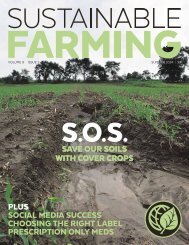
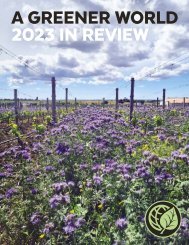
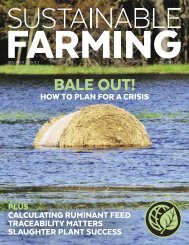

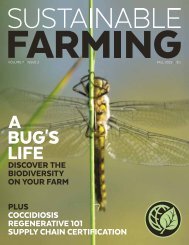
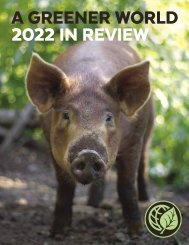
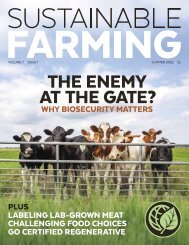
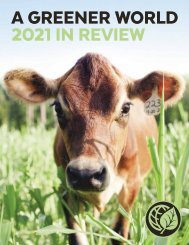
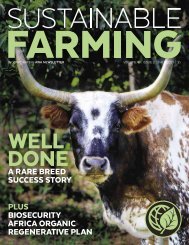




![SF Magazine V5 I1 -- Winter-Spring 2020 [SCREEN ONLY]](https://img.yumpu.com/63122871/1/190x245/sf-magazine-v5-i1-winter-spring-2020-screen-only.jpg?quality=85)